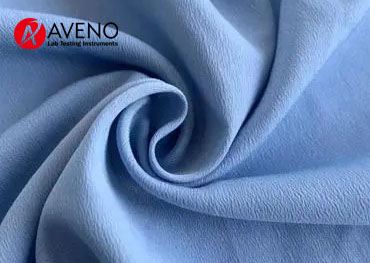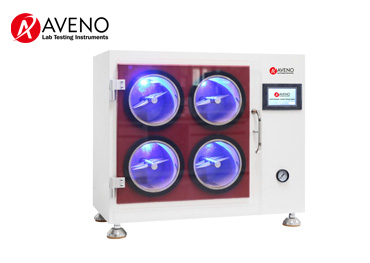-
 Common issues with textile color fastness
Jul 16 , 2024
Common issues with textile color fastness
Jul 16 , 2024
In daily use and consumer feedback, it has been found that the most common issues with textile color fastness are as follows: 1. Unqualified color fastness to friction During daily use, textiles may experience varying degrees of color fading due to different degrees of friction. For example, the sleeves of clothes, the hips, and knees of pants are all parts of our clothing that are prone to color ...
Read More
-
 What’s the Digital Air Permeability Tester used for
Jun 27 , 2024
What’s the Digital Air Permeability Tester used for
Jun 27 , 2024
Textile Air Permeability Tester is used to test the air permeability of special industrial fabrics, general fabrics, knitted fabrics, coated fabrics, non-woven fabrics and industrial filter paper. Conforms to the following standards: GB/T 5453, GB/T 13764, ISO 9237, ISO 7231, ISO 5636, BS 5636, ASTM D737, DIN 53887, JIS L1096. Do you want to know more about the Digital Air Permeability Tester? Inc...
Read More
-
 The Convenience and Accuracy of Random Tumble Pilling Tester Testing
Jun 24 , 2024
The Convenience and Accuracy of Random Tumble Pilling Tester Testing
Jun 24 , 2024
The quality of fabric anti-pilling performance plays a vital role in ensuring fabric quality and durability in the textile industry. The Fabric Random Tumble Tester is widely used in this field. This equipment provides very important reference data in evaluating the pilling performance of fabrics. Let's explore how the Random Tumble Pilling Test Equipment provides convenience and accuracy for our ...
Read More
-
 A technician’s perspective on the Spray Rating Tester
Jan 08 , 2024
A technician’s perspective on the Spray Rating Tester
Jan 08 , 2024
As a quality control technician in the textile industry, one of the instruments that plays a vital role in the process of evaluating products is the Fabric Spray Rating Tester. The spray tester is used to determine the water-repellency of any fabric (which may or may not have a water-repellent finish) to a water-wetted surface. It is not designed to predict water resistance as it does not measure ...
Read More
-
 About the Random Tumble Pilling Tester
Jun 26 , 2023
About the Random Tumble Pilling Tester
Jun 26 , 2023
The random tumbling pilling tester is a textile testing equipment used to determine the pilling resistance of woven or knitted fabrics. Pilling is the formation of small balls or pills on the surface of fabrics due to abrasion over time, which can affect the appearance and texture of the fabric. The random tumbling pilling tester works by tumbling a fabric sample in a rotating chamber that contain...
Read More
-
 Precautions for using the ICI Pilling and Snagging Tester
Aug 22 , 2022
Precautions for using the ICI Pilling and Snagging Tester
Aug 22 , 2022
The display of the ICI Pilling and Snagging Tester adopts a touch screen, the interface is simple and easy to understand, the operation is simple, the touch is sensitive, and the appearance of the fuselage is simple and elegant. The ICI Pilling and Snagging Tester is used for Pilling Test of wool, knitted fabrics and other fabrics that are easy to pilling, so as to evaluate the pilling grade of fa...
Read More
-
 Testing method of tester for rubbing color fastness of textiles
Jun 14 , 2022
Testing method of tester for rubbing color fastness of textiles
Jun 14 , 2022
Electronic Crockmeter is used to determine the colour fastness of textiles dry or wet rubbing, suitable for coloured fabric, coated, printed and dyed textiles. Textile rubbing color fastness tester test steps are as follows: 1. Use a cutter to cut two clean, flat, wrinkle-free and damage-free samples that meet the standard size on the sample. One for dry rubbing and one for wet rubbing. 2. Place t...
Read More
-
 Precautions of AATCC Electronic Crockmeter
Jun 13 , 2022
Precautions of AATCC Electronic Crockmeter
Jun 13 , 2022
AATCC Electronic Crockmeter introduction: 1. Rubbing Crockmeter is a reciprocating linear motion of a standard length with a standard weight of a friction head at a standard frequency. When the set number of times is reached, the motor automatically stops running. 2. Mainly used in cotton, wool, linen, silk, knitting, printing and dyeing and other industries, as a test instrument for measuring the...
Read More
-
 What are the factors affecting shrinkage?
Jun 01 , 2022
What are the factors affecting shrinkage?
Jun 01 , 2022
What is fabric shrinkage? Fabric shrinkage refers to the percentage of fabric shrinkage after washing or soaking. Shrinkage is a phenomenon that the length or width of textiles changes after washing, dehydration and drying in a certain state Synthetic fibers and blended textiles have the smallest shrinkage rate, followed by wool fabrics, linen fabrics, and cotton fabrics. The shrinkage rate of fab...
Read More
 Common issues with textile color fastness
Jul 16 , 2024
Common issues with textile color fastness
Jul 16 , 2024
 What’s the Digital Air Permeability Tester used for
Jun 27 , 2024
What’s the Digital Air Permeability Tester used for
Jun 27 , 2024
 The Convenience and Accuracy of Random Tumble Pilling Tester Testing
Jun 24 , 2024
The Convenience and Accuracy of Random Tumble Pilling Tester Testing
Jun 24 , 2024
 A technician’s perspective on the Spray Rating Tester
Jan 08 , 2024
A technician’s perspective on the Spray Rating Tester
Jan 08 , 2024
 About the Random Tumble Pilling Tester
Jun 26 , 2023
About the Random Tumble Pilling Tester
Jun 26 , 2023
 Precautions for using the ICI Pilling and Snagging Tester
Aug 22 , 2022
Precautions for using the ICI Pilling and Snagging Tester
Aug 22 , 2022
 Testing method of tester for rubbing color fastness of textiles
Jun 14 , 2022
Testing method of tester for rubbing color fastness of textiles
Jun 14 , 2022
 Precautions of AATCC Electronic Crockmeter
Jun 13 , 2022
Precautions of AATCC Electronic Crockmeter
Jun 13 , 2022
 What are the factors affecting shrinkage?
Jun 01 , 2022
What are the factors affecting shrinkage?
Jun 01 , 2022